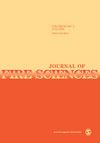通过改变薄防火毯的辐射特性优化其性能
IF 1.9
4区 工程技术
Q2 ENGINEERING, MULTIDISCIPLINARY
引用次数: 0
摘要
在野火中使用薄防火毯保护结构时,辐射(反射和发射)的散热对于良好的性能至关重要。通过改变毯子正面和背面的辐射特性,本文对入射热通量的几种情况进行了优化研究,包括纯对流、纯辐射以及两者的组合。在优化方案中,研究了两种类型的毯式挡热效率。总效率被定义为在特定的野火场景中,阻挡的入射热量与入射热量的总量之比。瞬时热阻断效率被定义为阻断到瞬时入射总热通量的瞬时热通量,这提供了对准稳态条件下防火毯热阻断机制的物理理解。除了最大化这些阻热效率外,还有其他优化目标,包括最小化橡皮布背面温度。将遗传算法用于多目标优化方案。对于瞬态热入射,整个时间序列的优化是在火灾序列期间,考虑到入射热引起的迎火表面变化,毯子辐射特性可能发生变化的情况下进行的。本文章由计算机程序翻译,如有差异,请以英文原文为准。
Performance optimization of thin fire blankets by varying their radiative properties
In using thin fire blankets to protect structures in wildfires, heat rejections by radiation (reflection and emission) are essential for good performance. By varying the radiative properties of the front and back surfaces of the blankets, this article offers an optimization study of several scenarios of incident heat flux including pure convection, pure radiation, and combinations of the two. Two types of blanket heat-blocking efficiencies are studied in the optimization scheme. An overall efficiency is defined as the amount of incident heat blocked to the total amount of incident heat in specified wildfire scenarios. An instantaneous heat-blocking efficiency is defined as the instantaneous heat flux blocked to the instantaneous incident total heat flux which provides good understanding of the physics of heat-blocking mechanisms of fire blanket under quasi-steady conditions. In addition to maximizing these heat-blocking efficiencies, there are other optimization objectives, including the minimization of the blanket backside temperature. A genetic algorithm is used for the multi-objective optimization schemes. For the transient heat incidence, the optimization for the entire time sequence is performed with the possibility of a change of blanket radiative properties during the fire sequence, accounting for changes to the fire-facing surface caused by the incident heat.
求助全文
通过发布文献求助,成功后即可免费获取论文全文。
去求助
来源期刊

Journal of Fire Sciences
工程技术-材料科学:综合
CiteScore
4.00
自引率
0.00%
发文量
14
审稿时长
2.5 months
期刊介绍:
The Journal of Fire Sciences is a leading journal for the reporting of significant fundamental and applied research that brings understanding of fire chemistry and fire physics to fire safety. Its content is aimed toward the prevention and mitigation of the adverse effects of fires involving combustible materials, as well as development of new tools to better address fire safety needs. The Journal of Fire Sciences covers experimental or theoretical studies of fire initiation and growth, flame retardant chemistry, fire physics relative to material behavior, fire containment, fire threat to people and the environment and fire safety engineering. This journal is a member of the Committee on Publication Ethics (COPE).
 求助内容:
求助内容: 应助结果提醒方式:
应助结果提醒方式:


